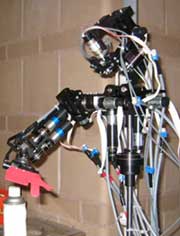With ATMs, online shopping, voice mail, self-service gas pumps, self-service supermarket checkout lanes and check-in kiosks at airports and hotels, we interact more with machines and less with people than ever before. As a result,
we do a lot more work than before... and some of us are getting fed up.
"We're exhausted doing all this work," says author and self-service critic Nicols Fox. "There's just so much that we have been asked to take over. I think we are reaching a breaking point here." Fox, who owns a bookstore in Maine, refuses to do business with distributors who charge more for phone orders than online orders. Fox may be in the minority, but her frustration indicates a deeper problem with our self-service society.
Many aspects of today's self-service are poorly designed, causing more problems than they solve. Plus, today's machines just aren't very smart. ATMs, for instance, are a proven technology that works very well for
specific tasks, such as getting cash out of your checking account. It solves the problem of accessing cash regardless of the bank's hours, and allowing you to access that cash in non-traditional locations. But for more complex banking needs, or when a problem arises, we want to talk to a human with functioning brain cells.
Self-service check-in kiosks at airports are another case in point. Normally they work wonderfully, speeding up an otherwise tedious process. But recently, I tried to check in for a flight at a United Airlines kiosk, which repeatedly told me that it could not find my flight or my reservation in its database. Slightly panicked, I went to the check-in desk and spoke to an attendant. He immediately knew what was wrong; my e-ticket was marked for United but the flight was actually on US Airways (the two service each other's routes). So I simply went to the kiosk at US Airways and checked in without a problem. The moral: the kiosks weren't smart enough to tell me I was in the wrong place, but the human attendant was.
Some self-service processes succeed precisely
because they remove the human factor. I speak here of self-service gas pumping. Living in New Jersey, where self-service fueling is illegal, it can take me as long as 20 minutes on a busy day between the time I pull into a service station and the time I leave. I have to wait for an attendant to get to me, take my credit card, get my order right (interesting how many times they "accidentally" give you premium instead of regular), come back to take the pump out, and charge my card (yes, I could save time by giving them exact cash, but not much). And that's not to mention the times they fail to put the gas cap back on properly or slop gas on the car (which does wonders for both the paint job
and the environment). This is not to disparage conscientious, competent gas attendants, but when I pump gas myself, I can be in and out in five minutes, tops. No fuss, no muss.
Yet other self-service processes are kludgy, in want of a more elegant solution. Self-service checkout lanes in grocery stores are a perfect example of a process that's no less complex than the one it's supposed to replace. Unless you have only a few items, self-service checkouts take far longer than lanes with a human cashier. The problem is that the self-service checkout lanes don't automate or streamline anything; they merely make you do the cashier's job. Half the time, a problem arises whereby a clerk needs to reset the machine, negating any labor savings on the part of the store, and any time savings on the part of the shopper. In fact,
self-service checkout aisles worked so poorly for Kmart that they yanked them out of their stores not long after introducing them. In the stores where I shop, the only thing that makes the self-service checkout lanes faster is the fact that almost no one uses them, so there's never a line.
Self-service checkout aisles are not a bad concept in of themselves; they're just missing a few components. RFID tags on products and contactless payment systems would complete the equation, allowing shoppers to simply walk out of the stores and have their orders charged to their credit or debit cards automatically. Instead of trying to automate an already labor-intensive system, this would eliminate the checkout process altogether, saving time for consumers while lowering labor costs.
Of course, the system might not be smart enough to realize that an RFID tag or your smartcard is malfunctioning, triggering the shoplifting alarm or charging you $200 for a $2 item. In that case, you'll be grateful for the human clerk who can set things right... assuming one is around.
Source:
Chicago Tribune






























